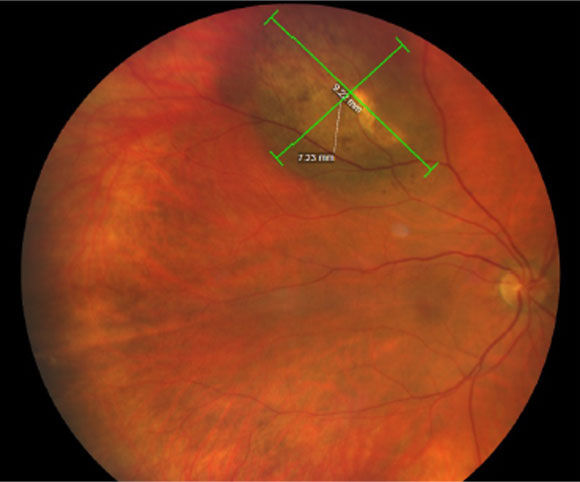 |
|
Pigmented tumors had a propensity to occur anterior to the equator whereas non-pigmented tumors tended to occur in the macula to equator region. Photo: Amy Bade, OD, Carolyn Majcher, OD, and David Simpson, OD. Click image to enlarge. |
The role of melanogenesis in the development of melanoma as well as the extent to which genetic and biochemical tumor characteristics are linked with pigmentation within uveal melanoma remain poorly understood. Researchers from Wills Eye Hospital in Philadelphia reviewed a large cohort of over 6,000 eyes with choroidal and ciliary body melanoma to evaluate clinical features and outcomes associated with the degree of tumor pigmentation. They determined that patients with pigmented uveal melanomas demonstrate a higher 10-year rate of metastatic disease and have decreased metastatic survival relative to partially pigmented and non-pigmented ones.
There were 6,934 eyes with uveal melanoma, and the degree of tumor pigmentation was classified as pigmented (54%), partially pigmented (31%) or non-pigmented (15%). Data on patient demographics, tumor characteristics, treatment approach and clinical outcomes were collected. Comparisons between pigmented (>80% pigmentation by surface area), partially pigmented (20% to 80%), and non-pigmented tumors (<20%) were performed using relevant hypothesis testing.
In this study, which was published in Ophthalmology Science, pigmented uveal melanoma was associated with extraocular extension, ocular melanocytosis, earlier tumor recurrence and a more anterior tumor epicenter location (ciliary body, and equator to ora serrata). Pigmented melanomas also exhibited the highest 10-year metastasis rate at 26%, compared with 19% for partially pigmented melanomas and 16% for non-pigmented melanomas. The researchers noted that this relationship was most pronounced when comparing pigmented uveal melanomas with non-pigmented ones rather than with the partially pigmented, indicating a trend of increasing risk with degree of pigmentation.
“Our findings suggest that tumor pigmentation evaluation by indirect ophthalmoscopy is a potentially valuable method for identifying patients at higher risk of metastasis, even before the results of genetic testing are available,” the researchers concluded in their paper.
Goldstein SJ, Bayasi F, Thomas G, et al. Impact of tumor pigmentation in 6,934 patients with uveal melanoma at a single center. Ophthalmol Sci. July 26, 2024. [Epub ahead of print]. |


